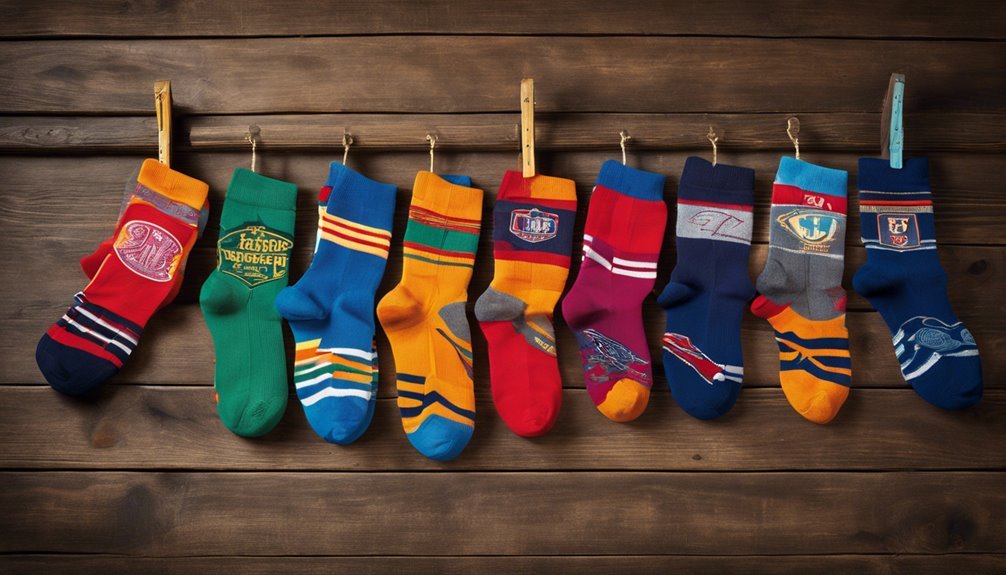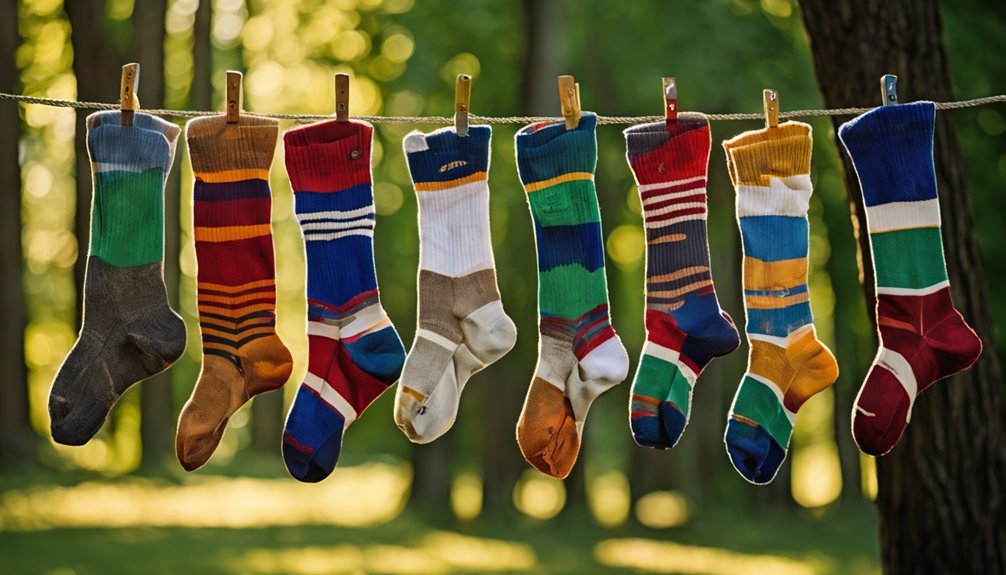The History of ‘Lucky Socks’ in Sports and Superstitions
Have you ever noticed how many athletes have quirky pre-game rituals? Lucky socks in sports are a fascinating blend of tradition and psychology, providing athletes with psychological comfort and a sense of control amidst the unpredictability of competition.
This practice can be traced back to Ancient Greece, where specific garments were believed to symbolize divine protection. Renowned athletes like Michael Jordan and Serena Williams have embraced these rituals, each adding their unique twist.
Despite modern advancements, such superstitions continue to emotionally anchor athletes, offering an intriguing glimpse into the human psyche. Explore further to better understand this captivating dynamic.
The Origins of Superstitions in Sports

Though superstitions in sports may seem irrational, they often have deep-rooted origins that blend psychology, tradition, and culture. You might wonder why athletes cling to certain rituals or objects. It's not just about luck; it's about control in an unpredictable world. The superstitious origins of these practices can be traced back to the need for psychological comfort and stability. Athletes, facing immense pressure, find solace in routines that have historically been associated with favorable outcomes.
These athletic beliefs are more than mere quirks; they're a tapestry woven from cultural influences and personal experiences. They serve as mental anchors, enabling you to focus amidst chaotic competition. While some may view them as constraints, they're actually tools for enhancing performance and maintaining mental freedom.
Early Instances of Lucky Socks in Athletic History
While the concept of lucky socks might seem whimsical, its roots in athletic history reveal a fascinating interplay between ritual and performance. Ancient athletes often engaged in rituals, embedding textile beliefs into their preparation. These beliefs symbolized not just protection but also a connection to the divine. In ancient Greece, for instance, athletes might've worn particular garments, including socks, believing they were imbued with luck or favor from the gods. This practice highlights a broader cultural context where clothing carried significant symbolic value. As you explore these early instances, it's clear that such rituals were not mere superstition but rather a profound expression of the athlete's desire for control over the unpredictable nature of competition, seeking not only victory but spiritual alignment.
Psychological Impact of Superstitions on Performance

Superstitions, such as the wearing of lucky socks, can greatly influence an athlete's psychological state, affecting both mindset and performance. You might find that such rituals bolster psychological resilience, providing a mental safety net during high-pressure situations. This belief in luck can create a sense of control, reducing anxiety and fostering confidence. However, cognitive biases can also emerge. You may overestimate the impact of these superstitions, attributing success or failure to luck rather than skill or effort. This could lead to dependence, potentially hindering adaptability and growth. Yet, when embraced judiciously, these practices can enhance focus and motivation. Ultimately, understanding the balance between superstition and skill allows you to harness their psychological benefits without limiting personal freedom.
Famous Athletes and Their Lucky Socks Stories
Throughout sports history, many athletes have shared intriguing tales about their lucky socks, demonstrating the unique role these garments play in their careers. Such stories reveal a fascinating intersection of personal belief and performance. You see, sock rituals aren't just about superstition; they're about creating a psychological edge. Consider the anecdote of Michael Jordan, who famously wore his college team's shorts under his Chicago Bulls uniform, influenced by a deep-seated belief in luck and tradition. Similarly, Serena Williams has been known to wear the same pair of socks throughout a tournament, adhering to her own sock rituals. These athlete anecdotes reflect a strategic blend of habit and psyche, offering a glimpse into how personal superstitions can coexist with professional success.
Cultural Variations in Sports Superstitions

When considering sports superstitions, you can't overlook how regional rituals greatly shape athletes' behaviors. In some cultures, specific pre-game practices are believed to enhance performance, while others rely on particular objects or routines for good luck. Understanding these traditions provides insight into how cultural contexts influence sports, where what seems like a simple action can hold profound personal meaning for athletes.
Regional Superstitious Rituals
Although many sports fans and athletes may not openly admit it, superstitious rituals are deeply ingrained in the cultural fabric of sports worldwide. You'll notice that regional practices often reflect unique belief systems, showcasing diversity in how luck is courted. For example, in certain parts of Europe, spectators might engage in rituals before a match to guarantee favorable outcomes for their teams. In contrast, South American athletes might rely on specific pre-game chants passed down through generations. These practices are less about logic and more about cultural identity.
- Brightly colored banners waving in the wind: A sign of unity and collective hope.
- Rhythmic clapping echoing through stadiums: A pulse of shared anticipation.
- Intricate face paint patterns: Personal and team symbols of protection.
In seeking freedom from outcome uncertainty, these rituals persist.
Traditions Influencing Athlete Behavior
In the domain of sports, athlete behavior is often influenced by a complex web of traditions and superstitions that vary widely across cultures. These athlete rituals, whether it's wearing lucky socks or following specific pre-game routines, serve as a form of mental conditioning. They provide a sense of control and comfort in the unpredictable world of sports. By adhering to these traditions, athletes can potentially enhance their focus, reduce anxiety, and improve performance. You might find that these rituals differ greatly depending on cultural backgrounds, reflecting diverse historical and societal influences. While some might view these practices skeptically, for many athletes, they are indispensable. The freedom to choose personal rituals allows athletes to shape their mental landscape uniquely.
The Science Behind Rituals and Confidence
Understanding the science behind rituals and confidence reveals how seemingly trivial actions, like wearing a pair of lucky socks, can greatly impact an athlete's psychological state. Ritual psychology suggests that repeated behaviors, even as simple as donning those special socks, create a sense of order and predictability. This predictability fosters a mental environment where confidence can flourish, offering an essential boost before a high-stakes performance. By creating this mental framework, athletes can focus on their skills rather than external pressures.
Consider the imagery:
- A football player lacing up worn socks before every game.
- A tennis champion adjusting their wristbands with precision.
- A runner tapping their shoes three times before the starting gun.
These actions aren't just habits; they're powerful psychological tools.
How Social Media Amplifies Superstitious Beliefs
You're likely aware of how swiftly superstitions can spread once they gain traction on social media platforms. Influencers sharing their personal pre-game rituals can lend credibility and make these beliefs seem more widespread. Furthermore, online communities create spaces where individuals can exchange and reinforce these superstitious practices, enhancing their perceived validity.
Viral Superstitions Spread Quickly
While superstitious practices have always been part of sports culture, social media has transformed the way these beliefs are shared and adopted. Viral trends enable superstitions to evolve at an unprecedented pace, making once-local practices global phenomena. You're no longer confined by geography; you can discover and adopt rituals from halfway across the world with a simple scroll through your feed. This rapid spread creates a unique cultural tapestry, where diverse superstitions merge and adapt.
- Hashtags spark curiosity, turning a quirky ritual into a widespread craze.
- Videos capture moments, making personal superstitions relatable and easily shared.
- Memes add humor, helping superstitions gain traction through entertainment.
In this digital age, you're free to explore and even create your own superstitious beliefs.
Influencers Share Personal Rituals
When influencers share their personal rituals online, it adds a new dimension to the way superstitions are perceived and adopted in sports. You see these influencer rituals, often steeped in personal anecdotes, resonate with audiences seeking a sense of freedom in their own athletic pursuits. The power of an influencer's narrative can transform quirky practices into widely accepted conventions, encouraging viewers to explore and embrace their own unique superstitions. This digital age allows for an unprecedented spread of ideas, where a single post can ignite a trend. As influencers reveal their pre-match rituals, from wearing lucky socks to specific warm-up routines, they provide relatable frameworks for others, illustrating how personal beliefs can shape performance and mindset in sports.
Online Communities Foster Beliefs
As digital landscapes expand, online communities play a pivotal role in amplifying superstitious beliefs, especially within the sports domain. Through online forums, individuals connect and nurture collective beliefs about rituals like wearing lucky socks. The virtual world allows these ideas to spread rapidly, uniting fans across the globe who share similar convictions. In this space, you'll discover:
- Images of fans donning their lucky socks on game days, fueling a shared sense of hope.
- Stories of miraculous victories attributed to these rituals, reinforcing their perceived power.
- Guides on creating your own luck-driven routines, encouraging participation in the tradition.
This exchange of ideas offers a sense of belonging, yet challenges your freedom by potentially anchoring your actions to shared superstitions in the digital age.
The Future of Superstitions in Modern Sports
Despite the rapid advancement of technology and analytics in modern sports, superstitions like lucky socks continue to hold sway over athletes and fans alike. Future trends suggest that as sports evolve, so too will these beliefs. Digital rituals could emerge, influenced by global trends and cultural integration, creating new layers of superstition sustainability. Athlete psychology plays an essential role in maintaining these practices, as they can offer a sense of control or performance enhancement. While empirical data may question their validity, the psychological comfort they provide cannot be underestimated. As global influences reshape sports culture, expect evolving beliefs to adapt accordingly, merging tradition with innovation. Superstitions, deeply rooted in human nature, may persist as a reflection of sports' enduring emotional dimension.
Frequently Asked Questions
Do Lucky Socks Have Any Impact Outside of Sports?
You've likely wondered if lucky socks affect areas beyond sports. From a psychology perspective, they can boost confidence and reduce anxiety. Culturally, they symbolize tradition and belief, offering a sense of control and freedom in unpredictable situations.
How Do Sports Brands Capitalize on the Superstition of Lucky Socks?
Ever wonder how sports brands weave magic into their products? They leverage brand marketing and consumer psychology to sell 'lucky socks,' tapping into beliefs for profit. It's about creating perceived value, crafting desires, and enhancing athlete confidence.
Are There Any Famous Incidents Involving Unlucky Socks?
You've probably heard tales of cursed equipment, but unlucky socks are rarer. Some athletes believe sock rituals, like wearing mismatched pairs, break curses. In sports, it's about mental freedom, challenging perceived limitations through personal rituals and beliefs.
Do Athletes Often Replace Their Lucky Socks or Keep the Same Pair?
You might think athletes would replace worn-out socks, but their sock replacement habits often defy logic. Rituals dictate keeping the same pair, highlighting the emotional attachment and superstition over practicality, offering a unique freedom in tradition.
What Are the Most Unusual Superstitions Involving Clothing in Sports?
You've likely heard of sock rituals, but athletes also engage in wearing mismatched shoes or inside-out shirts. These quirky fashion trends reflect personal beliefs, offering psychological freedom and control, essential for peak performance under pressure.







